#Trinidad and Tobago's national instrument
Photo
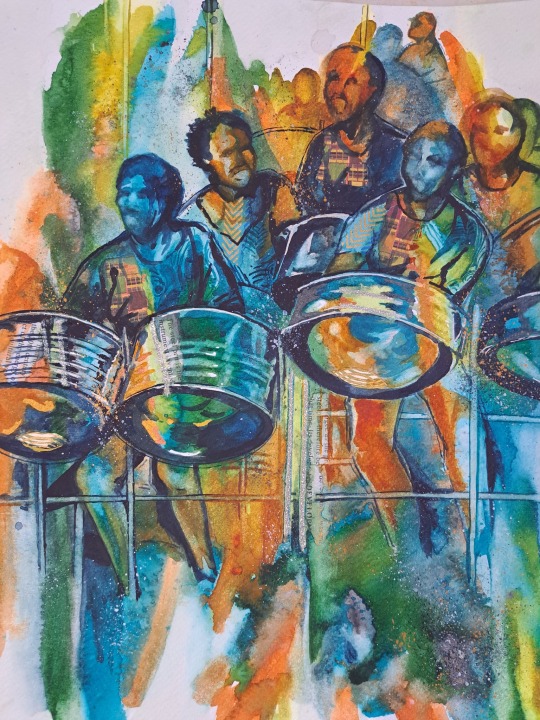

Sexypink - Tessa Alexander Sloane Seale - Carnival work in Trinidad and Tobago-2023
..............................
Statement from Tessa herself ....
Carnival comes home and we celebrate 60yrs of Panorama!
Who ready...Living Ritual series 2023.
Each watercolour and collage pan piece is 11x14" (28x35.6cm) but can be combined to form a larger piece as shown.
This series incorporates my research on ancestral art techniques and textiles acknowledging the contributions of those who against all odds gifted us with our carnival culture.
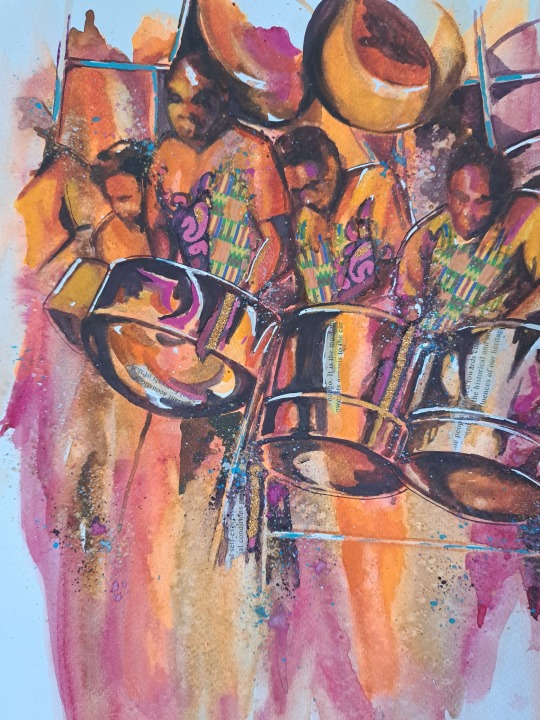

#sexypink/Tessa Alexander Sloane Seale#sexypink/Trinidad and Tobago Carnival#sexypink/watercolor painting#mixed media#Tessa ALexander Sloane Seale#Panorama#steelband#Trinidad and Tobago's national instrument#Pan#60 years of Pan#collage
11 notes
·
View notes
Text



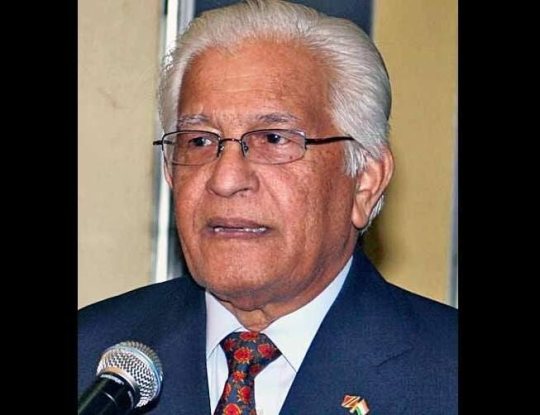
Galleryyuhself - Former Prime Minister of Trinidad and Tobago The Right Honorable Basdeo Panday has passed away. His is a shattering loss to the nation. May he rest in power.
#galleryyuhself/Prime Minister Basdeo Panday#galleryyuhself/bereavement#galleryyuhself/political leaders#galleryyuhself/Trinidad and Tobago politics#tumblr/Prime Minister Basdeo Panday#tumblr/Past Leaders of Trinidad and Tobago#Basdeo Panday#Union Leader#Pan as a national instrument#Indo/Trinbagonian Leaders#maverick#son of the soil#leader#statesman
0 notes
Video
#steel pan#trinidad & tobago#national instrument#declared vs proclaimed#patrick manning#sat maraj#tabla#afro trinidad#indotrinidad#race relations#grenada#african diaspora#indian diaspora
0 notes
Text
OCTAfan's Obscure Obscure and Weird Musical Instruments Tournament Round 1 Part 5: Carillon VS steelpan


Essentially a tower of bells, the Carillon is probably the largest instrument in the lineup, being tied with the pipe organ. It is a percussion instrument that involves a keyboard... and at least 23 large bells that are casted in bronze. They are usually found in churches, but there's a mobile version, although that's still pretty large compared to most of the instruments in the tournament.
Hailing from the Caribbean, the steelpan is the national instrument of Trinidad and Tobago, and is referred to as 'the only instrument invented in the 21st century.' It's basically a steel drum container that that is tuned and hit with mallets.
#OCTAfan says stuff#OCTAfan's Obscure and Weird Musical Instruments Tournament#Carillon#Steelpan#Musical instruments#Tumblr poll#Tumblr tournament#Tournament poll
4 notes
·
View notes
Video
In celebration of our local culture, @google is honouring the national instrument of Trinidad and Tobago, which is called, the Steelpan, by drawing special attention to it as a Google #Doodle today dated Tuesday 26th July, 2022.DID YOU KNOW that the Steelpan (also known as or abbreviated as, Pan) is a musical instrument indigenous to the Caribbean islands of Trinidad and Tobago and is the ONLY acoustic musical instrument to be invented in the 20th century?This Doodle was illustrated and put together by Nicholas Huggins Nicholas Huggins Creative of Backyard Design Co, Mick Seegobin, Etienne Charles, Etienne Charles, Len Boogsie Sharpe, Josanne Meuzically'Fit Francis, @lukeawalker, @castro.pg14, Troubadour Recording Studios, @angelicamckinley and #BillySheeder 🇹🇹🛢
#trinidadandtobago#steelpan#pan#culture#googledoodles#didyouknow#dyk#didyouknowfacts#musicalinvention#lintromusicpublishing
4 notes
·
View notes
Text
Unveiling the Soul of Trinidad and Tobago: The Steel Pan Symphony
Jot down the first thing that comes to your mind.Steel Pan Melodic Symphony Flowing Through my Brain
As I sit here, surrounded by the rhythmic melodies of my homeland, Trinidad and Tobago, I can’t help but marvel at the wonder that is the steel pan. Originating from the beating heart of our nation, this extraordinary instrument isn’t just a musical marvel; it’s a symbol of our culture, history,…
View On WordPress
0 notes
Text
Nurturing Communities: The Ministry of Rural Development's Impact
In the vibrant landscape of Trinidad and Tobago, the Ministry of Rural Development and Local Government stands as a beacon of hope and progress for its people. With a steadfast commitment to uplifting rural communities, this ministry plays a pivotal role in fostering sustainable development and enhancing the quality of life for all citizens. At the heart of its mission lies a dedication to empowering localities, driving economic growth, and fostering social cohesion.
In Trinidad and Tobago, the Ministry of Rural Development and Local Government serves as a cornerstone for initiatives aimed at bolstering rural areas' infrastructure, services, and overall well-being. From the rolling hills of Trinidad to the picturesque shores of Tobago, the ministry's presence is felt, resonating through its various programs and projects designed to address the unique needs of each community.
In recent years, the Ministry of Rural Development Tobago has spearheaded numerous initiatives to promote sustainable agriculture, enhance access to education and healthcare, and improve infrastructure in rural areas. Through strategic partnerships with local stakeholders and international organizations, the ministry has been able to implement innovative solutions to longstanding challenges, driving positive change and fostering resilience in the face of adversity.
Similarly, the Ministry of Works Trinidad & Tobago plays a crucial role in supporting the rural development agenda by overseeing the planning, construction, and maintenance of critical infrastructure projects across the twin islands. From road networks to drainage systems, the ministry's efforts are instrumental in enhancing connectivity, facilitating commerce, and improving the overall quality of life for rural residents.
Central to the ministry's approach is a commitment to community engagement and grassroots empowerment. By actively involving local residents in the decision-making process and soliciting their input on development priorities, the ministry ensures that its initiatives are responsive to the needs and aspirations of the people they serve. Through capacity-building programs and training initiatives, the ministry also equips communities with the tools and resources they need to chart their own path to prosperity.
As Trinidad and Tobago continues on its journey of growth and development, the Ministry of Rural Development Trinidad remains steadfast in its commitment to building inclusive, resilient, and thriving communities. By harnessing the collective strength and ingenuity of its people, the ministry paves the way for a brighter future where every citizen has the opportunity to flourish and thrive. Together, we can create a nation where no community is left behind, and where the promise of progress reaches every corner of our beautiful islands.
#Ministry of Rural Development Tobago#Ministry of Rural Development and Local Government#Ministry of Works Trinidad & Tobago
0 notes
Text
World Steelpan Day honours the national instrument of Trinidad & Tobago - Global Voices
World Steelpan Day honours the national instrument of Trinidad & Tobago Global Voices http://dlvr.it/Stvrh2
0 notes
Text
When is the best time to visit Trinidad?

The main Carnival celebration in the Caribbean is the second largest in the whole world which is held in Port of Spain, Trinidad and it has a party day and parade day preceding Ash Wednesday. The celebration falls in February and the Costumes are intricate and stunning, and you can book your trip with us in advance if you can as the carnival season is high season and we provide the best Hotels Port of Spain. The outstanding Kentucky Fried Chicken is near this location on Frederick Street across Independence Square in Port of Spain and it made the Guinness World Records in the year 2000 for selling the greatest chicken in the world and also for making the maximum money in the world. All the Locals love their KFC and you can enjoy this too.
You can also enjoy the feelgood tunes of the steelpan which is the national instrument of Trinidad & Tobago. They were initially made from discarded oil drums when all hand drums were banned under British rule. You can also enjoy more than 450 species of birds making their home in the lush countryside of Trinidad & Tobago, making the islands prevalent destinations for birders. Guides are abundant, and you can enjoy your stay with us after visiting all these places. Also, the romantic swamp cruise that even the non-birders can relish is the avian plenty with the dusk cruise in the open wood boat through Trinidad’s Caroni Swamp and Bird Sanctuary. This area is the highest nesting site for Trinidad’s national bird which is “The Scarlet Ibis”. lots of these colourful red birds gather here early each evening to roost in the trees. As you cruise here, you might also see caimans in the water among the mangrove roots entwined above on branches and after finishing this you can enjoy with our budget-friendly hotel.
0 notes
Photo


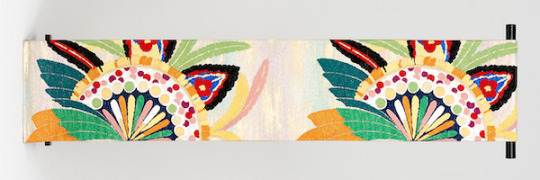

Parade of Nations - Trinidad and Tobago
French: Trinité-et-Tobago // English: Trinidad and Tobago // Japanese: トリニダード・トバゴ (Torinidādo Tobago)
Trinidad and Tobago formed its National Olympic Committee in 1946 and participated in its first Olympics as a country at the 1948 London Summer Olympics. They haven’t hosted any Olympic Games, but they’ve participated in 17 Summer Games and 3 Winter Games. The Olympic sports in which Trinidad and Tobago has medaled are Athletics, Swimming, and Weightlifting.
Kimono Maker: Takae Iguchi/ 井口 孝枝
“Based on the red and black national flags, I drew a bright image of the Caribbean Sea centered on the red national bird Scarlet Ibis and the red national flower Chaconia, which fly in groups. In addition, silver foil was placed on the circle that resembled the percussion instrument steelpan that originated in this country, and colorful birds and hummingbirds were drawn inside. It is said that it is a world-class carnival, and there are also feather decorations. In the center, the world's largest turtle, the leatherback turtle, is swimming towards Trinidad and Tobago.”[1]
Obi Maker: Nishijin-Maizuru/ 西陣まいづる
“The flower train that appears in the carnival and the gorgeous costumes of the feathers that decorate are the basis of the design. The dynamic feeling that makes you want to dance at any moment is expressed by hand weaving.” [1]
Bibliography
Source 1 – Kimono Project for Trinidad and Tobago
(https://kimono.piow.jp/nation/123.html)
Index Page – IOWKP x Tokyo 2020 Parade of Nations
#kimono#furisode#ofurisode#imagineoneworldkimonoproject#iowkp#tokyo2020#kimonoparadeofnations#kpon#trinidadandtobago#trinidadandtobagokimono#trinidadandtobagofurisode
43 notes
·
View notes
Text
What is WHO’s International Pandemic Treaty?
By Amit Dutta
‘Not if, but when’
“The question is not if, but when. Together, we must be better prepared to predict, prevent, detect, assess and effectively respond to pandemics in a highly coordinated fashion”, they said.
The main goal of the treaty, which would be rooted in the WHO Constitution, would be to foster a comprehensive approach to strengthen national, regional and global capacities and resilience to future pandemics, the leaders added.
Standing with WHO Director-General Tedros Adhanom Ghebreyesus, the leaders signing on so far, represent Albania, Chile, Costa Rica, the European Council, Fiji, France, Germany, Greece, Indonesia, Italy, Kenya, the Netherlands, Norway, Portugal, the Republic of Korea, Romania, Rwanda, Senegal, Serbia, South Africa, Spain, Thailand, Trinidad and Tobago, Tunisia, the United Kingdom, and Ukraine.
“At a time when COVID-19 has exploited our weaknesses and divisions, we must seize this opportunity and come together as a global community for peaceful cooperation that extends beyond this crisis”, the leaders said.
‘We must act boldly’: Dr. Tedros
Speaking at a press conference later in the day, WHO Director-General Dr. Tedros highlighted that the idea behind the proposal for the treaty is to “systematically tackle the gaps exposed by COVID-19”.
The pandemic has brought out the best and worst in humanity, he added, recalling “acts of incredible courage” from health workers and communities around the world, on a daily basis, but also inequalities in societies, geopolitical fault lines and frayed trust in public institutions.
“The impacts on our societies, economies and health, especially for the poor and the most vulnerable, are too significant”, Dr. Tedros said, stressing that “we cannot do things the way we have done them before and expect a different result…we must act boldly”.
He went on to note that the treaty would strengthen the implementation of the International Health Regulations (IHR) as well as provide a framework for international cooperation and solidarity.
It would help build resilience to pandemics and other global health emergencies, with robust national and global preparedness systems; ensure timely and equitable access to pandemic countermeasures, including vaccines; support sustainable funding and capacity for prevention, detection, and responses to outbreaks; and promote mutual trust.
Member States’ decision
Dr. Tedros also said that ultimately, the Member States would decide.
“How such a treaty is developed and what it looks like, and whether it is ratified, is a matter for our Member States – the nations of the world”, he added.
“We must leave a legacy for our children: a safer world for all.”
What's the purpose of an international agreement on pandemics?
The proposal for an international instrument on pandemic prevention, preparedness and response is guided by a spirit of collective solidarity, anchored in the principles of fairness, inclusiveness and transparency.
Neither individual governments nor the global community can entirely prevent pandemics. But the international community needs to be much better prepared and better aligned in responding to possible future pandemics across the entire cycle of detection, alarm and response.
The instrument would set out the objectives and fundamental principles in order to structure the necessary collective action to fight pandemics.
An international convention, agreement or other international instrument on pandemics would support and focus on:
early detection and prevention of pandemics
resilience to future pandemics
response to any future pandemics, in particular by ensuring universal and equitable access to medical solutions, such as vaccines, medicines and diagnostics
a stronger international health framework with the WHO as the coordinating authority on global health matters
the "One Health" approach, connecting the health of humans, animals and our planet
More specifically, such an instrument can enhance international cooperation in a number of priority areas, such as surveillance, alerts and response, but also in general trust in the international health system.
Information courtesy: United Nations, WHO, Council of the EU and the European Council
2 notes
·
View notes
Text




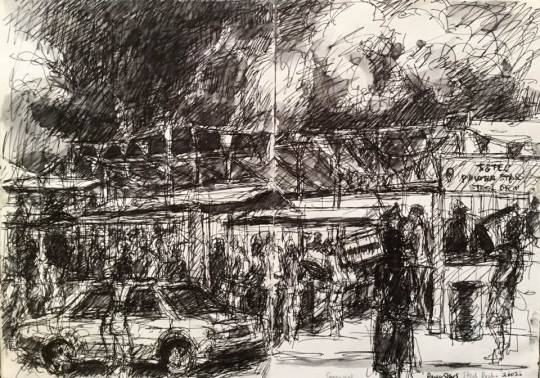
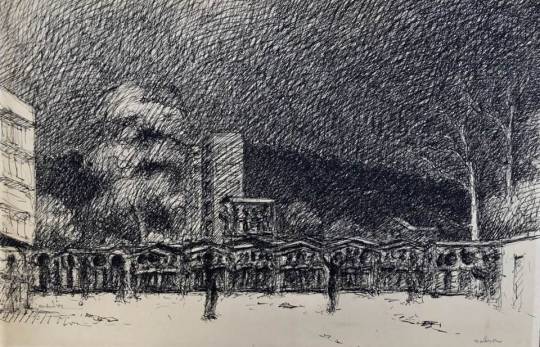
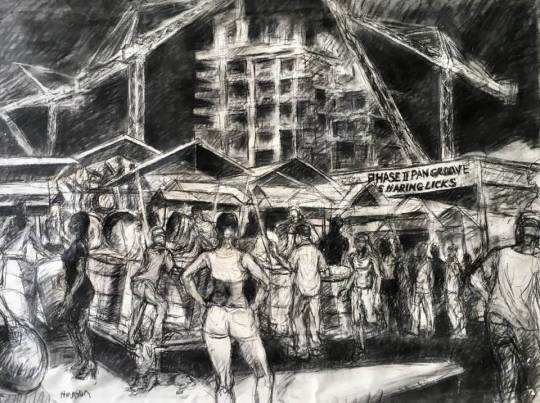
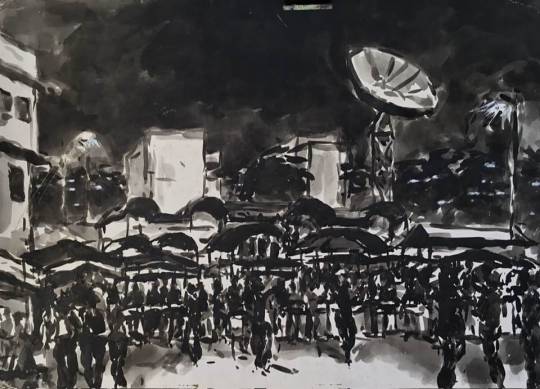
Sexypink - ARTISTS AND THEIR PROCESSES
Jackie Hinkson's drawings in order of dates
Invaders (no date)
Despers, 2023.
All Stars, 2014
Phase II
Mr Hinkson sketching in plein air pan style
T&TEC Power Stars, 2002
Renegades, 1980s
Phase II (no date)
Renegades (no date)
Trinidad and Tobago Artist Jackie Hinkson has had a stellar career as a Painter of scenes of life in the Caribbean. He is arguably the only person whose work can map the ever changing geographies of the islands. Here he is sketching his observations of players enjoying the national instrument on the roadways in August 2023, the year that PAN DAY became internationally official.
#Jackie Hinkson#Trinidad and Tobago Painters#Pan#Steelband#sketches over the years#tumblr/Jackie Hinkson#tumblr/charcoal drawings#drawings on paper#Artists and Icons#Trinidad and Tobago's national instrument#National Pan Day
1 note
·
View note
Text
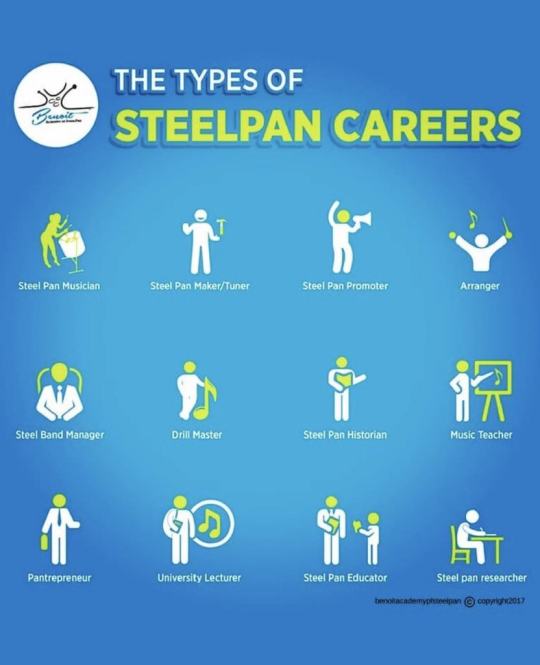
Galleryyuhself - Inforgraphics at its best.
#galleryyuhself/learning#galleryyuhself/infographics#galleryyuhself/pan jobs#galleryyuhself/Trinidad and Tobago's national instrument#tumblr/inforgaphics#tumblr/word and image#steelband#steel pan#pan#music#music jobs
0 notes
Text
In worldbuilding, one of the best touchstones you can give people is in arts. Music is especially great because it’s one of the longest lasting sense-memories people have, so giving that to your fictional characters makes them that much more real and relatable. ATLA, as a great fantasy world, makes great use of this (how many times have you sung a song from the show? be honest.) so this is a list of possible musical influences that could be part of the various nations outside of the music we’re given in-show. The musical possibilities with bending and having benders has just... so much cool potentital, because look at what we’ve got without even having powers!

Check it:
Earth kingdom – lithophones
The Earth Kingdom would have absolutely sick lithophones (instruments made from resonating stone).
Lithophones are also some of the oldest dated musical instruments, going back to prehistoric times, and can be found in locations/cultures around the globe (singing/ringing/sonic/resonant rocks of different types are everywhere) in both natural and man-made settings. (Musical caves/stalactite organs vs carved or shaped settings)
Some examples:
Bianqing: (also known as qing, biên khánh in Vietnam, and pyeongyeong in Korea) A stone gong originating from China, played in a set (or singular) hung on racks, with a characteristic angular shape. (Not to be confused with bianzhong, which are metal bells, often played together with bianqing.)
[example] [example] [example]
Ðàn đá: a stone mallet instrument from the western/central highlands of Viet Nam. They are a historic instrument and got a revival in the 1950s, so they are fairly common in the modern era as well.
[example] [example]
If you’re interested in checking out the work of Viet musicologists, check out their website: https://www.vienamnhac.vn/home-page
For a look into how stone based instruments can be made, check out this report from a small town in Japan that specializes in a specific type of musical stone (sanukite): https://www.kensanpin.org/en/report/no47/
Some examples of instruments made from sanukite: [example] [example]
(I can also totally see towns in the EK having stones specific to their region and their local musical tone.)
Post metalbending revolution they would probably partner up with…
The Fire Nation likely has a strong lean towards metallophones. In Western music the most well known of these would be vibraphones, glockenspiels, and bells. (In the ATLA soundtrack, a notable metallic sound is Azula’s signature sting.) But for the FN, more likely influences could be along the lines of:
Gamelan: this is a genre/type of ensemble from Indonesia, the main three styles being Javanese, Balinese, and Sudanese. (Styles depend on island of origin and cultural purposes.) It has a rich history and cultural importance that cannot be done justice in a few lines her, but it’s absolutely amazing music. Gamelan is used for religious/spiritual purposes, dance, puppeteering/storytelling, theater, general concerts, community gathers, and more. Ensembles range in size and instrumentation, but the main timbre is in the various metallophones (barred, gongs, cymbals, etc.), as well as drums, strings, woodwinds, and singers. [example] [example] [example]
[If you’re interested in learning more, the Wikipedia page https://en.wikipedia.org/wiki/Gamelan actually has whole video modules via youtube to learn about the various styles of gamelan and multiple sources both print and online to access!]
Steelpan/steel drums: Originating from Trinidad and Tobago, these instruments have a very universal popularity for their bright tone and accessibility. There are many variations on steelpan such as the hang drum, handpan, steel tongue drum, and others. [example] [example] [example]
For the polar Water Tribes, I’d imagine they’d have a much stronger oral/vocal tradition than instrumental, with the exception being portable/durable instruments like hands drums, bone flutes, etc. (So this section is a little less instrument based and more appropriate vibes.)
Vocal/oral tradition: It’s hard to find a culture that doesn’t have some form of oral or sung tradition, but with the cultural influences behind the Water Tribes, I’d guess that a strong tradition would be in throat singing. Throat singing is found in multiple indigenous cultures around the world with various styles of overtone singing (producing more than one tone at once). Some examples are:
Inuit - [one] [two]
Tuvan (Mongolian) - [one] [two] [obligatory plug for The Hu bc they are some of the coolest people on the planet]
Tibetan - [one] [two]
Italian - [one] [two]
Ainu - [one] [two]
Tan Dun, Water Music: Tan Dun is a composer who has done film scores and currently focuses on what he calls “organic music” where the main focus is using naturally occurring materials/sounds. [performance]
Water drumming: One of the coolest ensemble performances, just straight up using water as an instrument. These examples are from Vanuatu and the Baka people of Cameroon. [one] [two] [three] [four] [five]
Sea Organ: Located in Zader, Croatia, this experimental instrument is played by the tides and waves. [video]
Hand drums/frame drums: these styles of drums can be found around the world, throw a dart at a map and there’s probably a style of hand drum from there. They are among the simplest style of drum to make, needing a round frame and hide to stretch over it. Here are just a few examples: [one] [two] [three] [four] [five] [six]
Air Nomads probably had a hug musical tradition between the temples, skybison herding, and traveling. Both singing and wind instruments were probably very popular (we see Aang being able to play multiple instruments). Simple flutes make good travel instruments and being able to share news and information via song when stopping at towns would be a valued skill (in communities before reading was a common skill, it would usually fall to either dedicated criers or bards to pass along information in an understandable and memorable way).
Singing/chants: Learning songs from around the nations would be fun for those who travel, it’s easy to imagine an informal song competition for the most variety or strangest or most locations or dirtiest ones learned during their travels. But given the strong influence of Tibetan Buddhism on the Air Nomads, some traditional Tibetan vocal music examples (a couple of other examples are under the Water Tribe section as well)- [one] [two] [three] [four] [five]
(Tibetan musical notation is also regarded as some of the most beautiful in the world, I’d strongly recommend taking a look.)
Sheng- This is a free-reed mouth organ from China and it has an incredibly long history. Traditional shengs are handheld with few keys, more modern versions vary in size, number of pipes, and keys. It’s a pretty delightful instrument imo. [one] [two] [three]
Panflute: There a lots of different kinds of panflutes found around the world, the most famous being the Greek and Peruvian styles. Some different kinds include paixiao (China), wot (Laos, northern Thailand), nai (Romania, Moldova), siku (Andean), and kuvytsi (Slavic). Variations include the cut of pipes to produce the sound, arrangement of the pipes, and materials used.[siku] [paixiao] [wot 1] [wot 2]
It would also be very cool to have carvings into the mountains that could be played by airbending oh man.
All of these are, of course, just barely dipping a toe into the vast amounts of beautiful musical cultures out there, but hopefully it helps inform and build on what is there. If something tickles your fancy, please feel free to go digging and find more about it! (If you aren’t sure where to start, I’m happy to help, just drop me a line and I can at least point you in the right direction. I make no claim to be any kind of expert here, but I can get you to them!)
#atla#atla meta#worldbuilding#musical meta#headcanons#recovered the post from yesterday recovered lol
44 notes
·
View notes
Text
HI! I’m Shanice and i created this blog to share with you all my country, Trinidad and Tobago, National instrument the Steelpan.
What is a Steelpan?
Steelpans is a musical instrument originating from Trinidad and Tobago. Steelpan musicians are called pannists. The Modern pan is a chromatically pitched percussion instrument made from 55 gallon industrial drums that formally contained chemicals.
Drum refers to the steel drum containers from which the pans are made; the steel drum is more correctly called a steel pan or pan as it falls into the idiophone family of instruments, and so is not a drum (which is not a drum. Steelpans are the only instruments made to play in the Pythagorean musical of fourths and fifths.
The pan is struck using a pair of straight sticks tipped with rubber; the size and type of rubber tip varies according to the class of pan being played. Some musicians use four pansticks, holding two in each hand. This skill and performance have been conclusively shown to have grown out of Trinidad and Tobago's early 20th-century Carnival percussion groups known as Tamboo bamboo. The pan is the national instrument of Trinidad and Tobago.
4 notes
·
View notes
Text
World Steelpan Day honours the national instrument of Trinidad & Tobago - Global Voices
World Steelpan Day honours the national instrument of Trinidad & Tobago Global Voices http://dlvr.it/SttN2G
0 notes